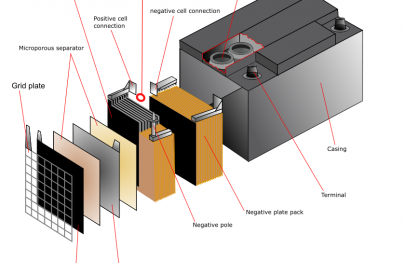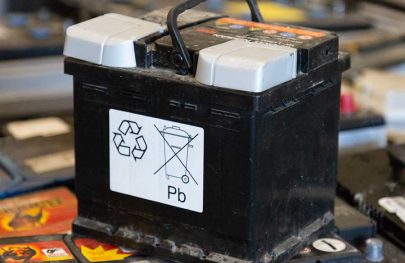
Lead Acid Batteries (Used)
Lead acid batteries are made up of plates, Lead, and Lead oxide situated in a “bath” of 35% sulfuric acid within a plastic casing and 65% water electrolyte solution. Lead acid batteries represent almost 60% of all batteries sold worldwide.
This means the typical Lead-acid battery comprises of: metal grids, electrode paste, Sulphuric acid, connectors and poles of Lead alloy, and grid separators made up of PVC. The battery components are contained in corrosion and heat-resistant housing usually composed of plastic (polycarbonate, polypropylene, or polystyrene).


Types of Lead Acid Batteries
Generally there are two types of Lead-acid storage batteries, based on their method of construction Flooded or Sealed. Flooded (or wet) Lead acid batteries are those where the electrodes / plates are immersed in electrolyte. Sealed Lead acid or valve-regulated Lead acid (VRLA) battery where the electrolyte is immobilized. All Lead-acid batteries produce hydrogen and oxygen gas (gassing) at the electrodes during charging through a process called electrolysis. These gases are allowed to escape a flooded cell, however the sealed cell is constructed so that the gases are contained and recombined.
Reusable Batteries
The reusable material from the used battery is removed and recycled which reduces the needs for raw materials which is originally imported from abroad. It creates a balance payment and cost. In addition to this there can be considerable environmental impact during mining processes such as emission from smelting of sulfide ore, copper, nickel, and cobalt and this can be eliminated if recycling can be introduced.


Valuable Commodity
Recycled lead is a valuable commodity and for many people in the developing world. the recovery of car and similar batteries (ULABs) can be a viable and profitable business. Therefore, the market for reclaiming secondary lead has been growing, especially in developing countries. Many developing countries have entered the business of buying ULABs in bulk in order to recycle them for lead recovery. These ULABs are often shipped over long distances for recycling, typically from the industrialized countries that produce, use, and then collect the spent batteries for reprocessing.
We also receive special types of batteries like gel cell, back ups for computers, emergency lighting, telephone communications, and certain tools.


